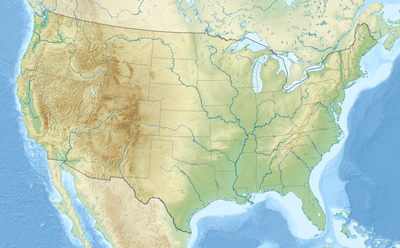History
The American bauxite industry held world importance during World War I, and from 1914 through 1920, supplied more than half the world's bauxite. In 1914 and again in 1915, the US supplied 94 percent of the world's bauxite.
Wartime aluminum demand for airplane construction during World War II caused bauxite production to jump more than 16-fold from 1939 to 1943. In 1943, US bauxite production peaked at 6.3 million tons, then fell back to 1.0 million tons in 1945. The US has supplied less than ten percent of world bauxite each year since 1956, and less than one percent each year since 1982.
From 1889 through 2013, a total of 94 million metric tons of bauxite were mined in the US, about 90 percent of which came from central Arkansas.
In 2013 the US mined 128,000 metric tons of bauxite.
Past and Present Bauxite Mining Areas in the US
Deposits
Bauxite forms by the weathering of aluminum-rich and silica-poor rocks in hot, humid, climates, at places with good drainage. Under the proper conditions, weathering disintegrates the aluminium silicate minerals, and dissolves and removes the silica, creating bauxite. The mined US bauxite deposits have all been in the southeastern United States.
Arkansas
About 90 percent of American-mined bauxite has come from deposits in central Arkansas. The Arkansas deposits were formed during the Eocene from weathering of intrusions of nepheline syenite, an aluminium-rich, silicate-poor, igneous rock.
Bauxite is still mined in Arkansas, but has not been mined for aluminium metal production since 1981. Alcoa operates a processing plant near Benton, Arkansas, which produces a high-strength proppant used in hydraulic fracturing of oil and gas wells. The bauxite is mined by McGeorge Contractors.
Eufaula, Alabama
Bauxite has been mined near Eufaula, Alabama since 1927. In 2007, 142 thousand short tons were mined, for use in chemical manufacture, abrasives, and high-temperature refractory materials. [3]
Andersonville, Georgia
Bauxite has been commercially mined in the Andersonville, Georgia district since 1914. Bauxite deposits occur in beds of kaolinite clay in the Nanafalia formation of the Wilcox group, of Eocene age. [4] Mining of bauxite and kaolinite is currently being done by Mullite Company of America (Mulcoa).
Spottswood, Virginia
Bauxite was mined at two mines near Spottswood, Virginia, from 1940 to 1946. Total production was about 30,000 long tons, from deposits associated with limestone. [5]
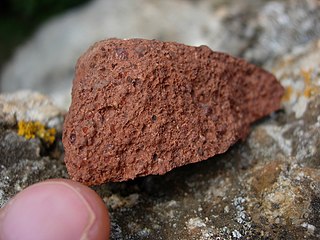
Bauxite is a sedimentary rock with a relatively high aluminium content. It is the world's main source of aluminium and gallium. Bauxite consists mostly of the aluminium minerals gibbsite (Al(OH)3), boehmite (Y-AlO(OH)) and diaspore (α-AlO(OH)), mixed with the two iron oxides goethite (FeO(OH)) and haematite (Fe2O3), the aluminium clay mineral kaolinite (Al2Si2O5(OH)4) and small amounts of anatase (TiO2) and ilmenite (FeTiO3 or FeO.TiO2). Bauxite appears dull in luster and is reddish-brown, white, or tan.

Kaolinite ( KAY-ə-lə-nyte, -lih-) is a clay mineral, with the chemical composition Al2Si2O5(OH)4. It is a layered silicate mineral, with one tetrahedral sheet of silica (SiO4) linked through oxygen atoms to one octahedral sheet of alumina (AlO6) octahedra.
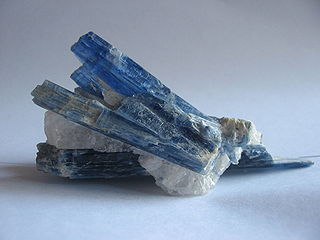
Kyanite is a typically blue aluminosilicate mineral, found in aluminium-rich metamorphic pegmatites and sedimentary rock. It is the high pressure polymorph of andalusite and sillimanite, and the presence of kyanite in metamorphic rocks generally indicates metamorphism deep in the Earth's crust. Kyanite is also known as disthene or cyanite.
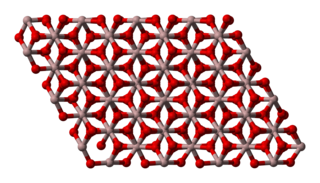
Aluminium oxide (or Aluminium(III) oxide) is a chemical compound of aluminium and oxygen with the chemical formula Al2O3. It is the most commonly occurring of several aluminium oxides, and specifically identified as aluminium oxide. It is commonly called alumina and may also be called aloxide, aloxite, or alundum in various forms and applications. It occurs naturally in its crystalline polymorphic phase α-Al2O3 as the mineral corundum, varieties of which form the precious gemstones ruby and sapphire. Al2O3 is significant in its use to produce aluminium metal, as an abrasive owing to its hardness, and as a refractory material owing to its high melting point.

Iron ores are rocks and minerals from which metallic iron can be economically extracted. The ores are usually rich in iron oxides and vary in color from dark grey, bright yellow, or deep purple to rusty red. The iron is usually found in the form of magnetite (Fe
3O
4, 72.4% Fe), hematite (Fe
2O
3, 69.9% Fe), goethite (FeO(OH), 62.9% Fe), limonite (FeO(OH)·n(H2O), 55% Fe) or siderite (FeCO3, 48.2% Fe).

Mining in Iran is still under development, yet the country is one of the most important mineral producers in the world, ranked among 15 major mineral-rich countries, holding some 68 types of minerals, 37 billion tonnes of proven reserves and more than 57 billion tonnes of potential reserves worth $770 billion in 2014. Mineral production contributes only 0.6 per cent to the country's GDP. Add other mining-related industries and this figure increases to just four per cent (2005). Many factors have contributed to this, namely lack of suitable infrastructure, legal barriers, exploration difficulties, and government control.

Crushed stone or angular rock is a form of construction aggregate, typically produced by mining a suitable rock deposit and breaking the removed rock down to the desired size using crushers. It is distinct from naturally occurring gravel, which is produced by natural processes of weathering and erosion and typically has a more rounded shape.

The Mining industry of Ghana accounts for 5% of the country's GDP and minerals make up 37% of total exports, of which gold contributes over 90% of the total mineral exports. Thus, the main focus of Ghana's mining and minerals development industry remains focused on gold. Ghana is Africa's largest gold producer, producing 80.5 t in 2008. Ghana is also a major producer of bauxite, manganese and diamonds. Ghana has 20 large-scale mining companies producing gold, diamonds, bauxite and manganese; over 300 registered small scale mining groups; and 90 mine support service companies.
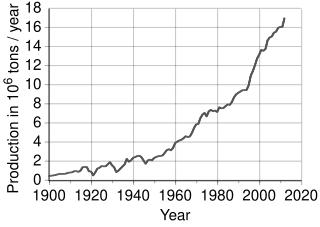
Peak copper is the point in time at which the maximum global copper production rate is reached. Since copper is a finite resource, at some point in the future new production from mining will diminish, and at some earlier time production will reach a maximum. When this will occur is a matter of dispute. Unlike fossil fuels, copper is scrapped and reused, and it has been estimated that at least 80% of all copper ever mined is still available.
Despite being a mineral rich country, Cameroon has only recently begun to investigate mining on an industrial scale. Strong metal and industrial mineral prices since 2003 have encouraged companies to develop mines here. The terrain mainly consists of granite-rich ground with areas of ultramafic rocks that are sources of cobalt and nickel. There are also deposits of bauxite, gold, iron ore, nepheline syenite, and rutile. Alluvial gold is mainly mined by artisanal miners.
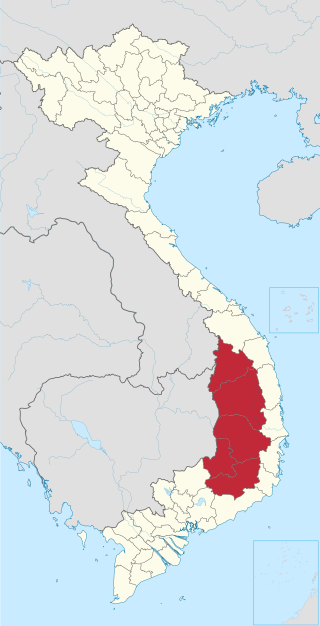
According to the United States Geological Survey, Vietnam is estimated to hold the world's third-largest bauxite ore reserves, after Guinea and Australia. The majority of Vietnam's reserves are located in the Central Highlands and have only been minimally mined. Bauxite is typically strip mined and is used to produce aluminum. According to estimates by Vietnam's Ministry of Industry and Trade, Vietnam's reserves in the Central Highlands amount to 5.4 billion tons. Despite its large reserves, Vietnam produces only 30,000 tons of bauxite per year.

Laterite is both a soil and a rock type rich in iron and aluminium and is commonly considered to have formed in hot and wet tropical areas. Nearly all laterites are of rusty-red coloration, because of high iron oxide content. They develop by intensive and prolonged weathering of the underlying parent rock, usually when there are conditions of high temperatures and heavy rainfall with alternate wet and dry periods. Tropical weathering (laterization) is a prolonged process of chemical weathering which produces a wide variety in the thickness, grade, chemistry and ore mineralogy of the resulting soils. The majority of the land area containing laterites is between the tropics of Cancer and Capricorn.

Carborundum Universal Ltd (CUMI), a part of Murugappa Group, is one of the largest and oldest conglomerates in India. CUMI is the leading manufacturer and developer of abrasives, ceramics, refractories, aluminium oxide grains, machine tools, polymers, adhesives and electro minerals in India.
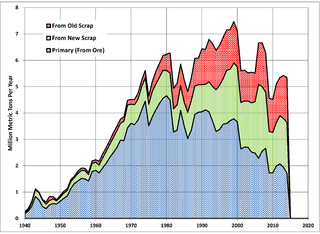
The aluminum industry in the United States in 2014 produced 1.72 million metric tons of primary aluminum, worth 3.97 billion dollars, at nine aluminum smelters. In addition, the US produced 1.70 million tons of secondary aluminum from old (post-consumer) scrap, and 1.93 million tons of aluminum from new (manufacturing) scrap. The US was the world's 6th largest producer of primary aluminum in 2014. The industry employed 29,000 people.
Mining in Guyana is a significant contributor to the economy owing to sizable reserves of bauxite, gold, and diamonds. Much of these resources are found in Guyana's Hilly Sand and Clay belt, a region that makes up 20% of the country.
The cement industry in the United States produced 82.8 million tonnes of cement in 2015, worth US$9.8 billion, and was used to manufacture concrete worth about US$50 billion. The US was the world's third-largest producer of cement, after China and India. The US cement industry includes 99 cement mills in 34 states, plus two plants in Puerto Rico. The industry directly employed 10,000 workers in 2015. Ten percent of the cement used in the United States in 2015 was imported.
In 2015, 27.6 million metric tons of marketable phosphate rock, or phosphorite, was mined in the United States, making the US the world's third-largest producer, after China and Morocco. The phosphate mining industry employed 2,200 people. The value of phosphate rock mined was US$2.2 billion.
The geology of Arkansas includes deep 1.4 billion year old igneous crystalline basement rock from the Proterozoic known only from boreholes, overlain by extensive sedimentary rocks and some volcanic rocks. The region was a shallow marine, riverine and coastal environment for much of the early Paleozoic as multi-cellular life became commonplace. At the end of the Paleozoic in the Permian the region experienced coal formation and extensive faulting and uplift related to the Ouachita orogeny mountain building event. Extensive erosion of new highlands created a mixture of continental and marine sediments and much of the state remained flooded even into the last 66 million years of the Cenozoic. In recent Pleistocene and Holocene time, glacial sediments poured into the region from the north, down major rivers, forming dunes and sedimentary ridges. Today, Arkansas has an active oil and gas industry, although hydraulic fracturing related earthquake swarms have limited extraction. Mining industries in the state also produce brines, sand, gravel and other industrial minerals.

Aluminum is the third most abundant element in the lithosphere at 82,000 ppm. It occurs in low levels, 0.9 ppm, in humans. Aluminum is known to be an ecotoxicant and expected to be a health risk to people. Global primary production (GPP) of aluminum was about 52 million tons in 2013 and remains one of the world's most important metals. It is used for infrastructure, vehicles, aviation, energy and more due to its lightweight, ductility, and cheap cost. Aluminum is harvested from gibbsite, boehmite, and diaspore which make up bauxite. The aluminum cycle is the biogeochemical cycle by which aluminum is moved through the environment by natural and anthropogenic processes. The biogeochemical cycle of aluminum is integral with silicon and phosphorus. For example, phosphates store aluminum that has been sedimented and aluminum is found in diatoms. Aluminum has been found to prevent growth in organisms by making phosphates less available. The humans/lithosphere ratio (B/L) is very low at 0.000011. This level shows that aluminum is more essential in the lithospheric cycle than in the biotic cycle.

Compagnie des bauxites de Guinée (CBG) is a Guinean mining company. Since 1963 it has extracted bauxite from the notable mine in Sangarédi, in Boké Region in Guinea. It is 49% owned by the Guinean State, with the remainder owned by the Boké Investment Company, a 100%-owned subsidiary of Halco Mining, a consortium opened in 1962 by Harvey Aluminum Company to run mining operations in Guinea. Halco's stock is owned by Alcoa (45%), Rio Tinto Alcan (45%) and Dadco Investments (10%).

